What's the Difference?
While the Randonneur collaboration bike was in my possession (it has now been shipped to its owner), for about a month I alternated between riding it and my own Rivendell in attempts to compare them.
When I mention the very idea of comparing these bikes I tend to get completely polarised reactions. To some they look identical: lugged frames, 650B wheels, wide tires, fenders, dynamo lighting, dropbars and classic handlebar bags. Can there possibly be significant differences in how they ride? To others, the bicycles are so obviously different in terms of geometry and tubing, that a comparison seems equally absurd: Of course they will be radically different!
So first, let me explain the two bicycles in a way that I hope does not get too technical. The green one on the left is the Rivendell Sam Hillborne. The frame has relaxed angles, long chainstays, and classic (mid/high) trail. The tubing is oversized to support heavy loads. The top tube is unusually long for the frame size and slightly sloped, for reasons to do with Rivendell's approach to bike fit. It is fundamentally a touring bike, but with some quirky qualities thrown in.
The blueish bike is a one-off collaboration between Royal H. Cycles and myself. Built as a classic randonneuring frame, it is made using skinny, somewhat flexible tubing with fairly steep angles, moderate length chainstays, and low trail. The Randonneur is supposed to be lighter, faster and more responsive than a touring bike, yet still comfortable. The low trail geometry is considered to be optimal for carrying a front load, but overall the bike is not meant to be heavily loaded.
Fully built up with similar components, the Randonneur indeed came out lighter than the Rivendell. Unfortunately I do not have a scale to weigh them - but I estimate maybe 4-5lb (when comparing with handlebar bags attached and everything else shown here). [Edited to add: The difference between these bicycles as shown is 6lb. The Randonneur weighs 26lb and the Sam Hillborne 31lb.]
The difference in tubing is immediately apparent, both when looking at the bikes in person and when picking them up by the top tubes - I can close my hand around the Randonneur's top tube much easier. This made the Randonneur easier for me to pick up, carry around when necessary, and take in and out of the house. As for how the tubing and other differences translate into ride quality, it is difficult to say. The Randonneur is a faster bike, though modestly so. It is also less fatiguing and perhaps a wee bit cushier over bumps. I can feel the frame and fork flex as I ride, but not too much. And I would certainly not attempt to do this on the Randonneur - I think the frame might bend in half.
Regarding the low trail geometry, I have yet to organise my thoughts on that topic. Suffice to say that I expected a "weirdness" in the bicycle's handling that, for me, just wasn't there (though an acquaintance who test rode the bike disagrees). Yes, it handled differently under some conditions - but the same can be said of almost every bike in comparison to almost every other bike.
And perhaps the biggest surprise of all, was that I did not feel a significant difference in the way the two bicycles behaved with a front load. Yes, the Randonneur is spectacular at carrying weight in the handlebar bag... but then so is the Rivendell. Maybe I am not as sensitive to this specific aspect of bicycle handling as others, but I am not sure I could feel a difference. I also did not think the Randonneur was at all "unridable" without a front load, as some warned me about. Again, it is possible that I simply lack the sophistication and experience to sense the difference, but there you have it.
When I initially planned to compare the low trail Randonneur to my Rivendell, I assumed that I would prefer one type of bicycle over the other. Instead, it became clear that the two bikes are simply optimised for different types of cycling. Both are versatile in that they can be ridden on and off road equally comfortably, are fully equipped, and can carry at least some of the cyclist's belongings. The Randonneur is a somewhat faster, lighter and more "precise" ride, but it would not work in a fully loaded capacity. The Rivendell can haul great quantities of stuff unflinchingly, but at the expense of that extra bit of speed and maneuverability. The Randonneur is, of course, a custom bike with all the attention to fit and craftsmanship that implies, so I am not comparing on that level. But as far as the ride quality goes both bikes are great, just for different, albeit overlapping, uses. As for what role low trail geometry plays in all of this, I am honestly still not sure. Despite my pages of elaborate notes about the Randonneur's handling, I cannot say it is "better" or "worse" than typical mid/high trail geometry. My impressions of the handling are vivid, but oddly devoid of a value judgment. Vive la différence?
When I mention the very idea of comparing these bikes I tend to get completely polarised reactions. To some they look identical: lugged frames, 650B wheels, wide tires, fenders, dynamo lighting, dropbars and classic handlebar bags. Can there possibly be significant differences in how they ride? To others, the bicycles are so obviously different in terms of geometry and tubing, that a comparison seems equally absurd: Of course they will be radically different!
So first, let me explain the two bicycles in a way that I hope does not get too technical. The green one on the left is the Rivendell Sam Hillborne. The frame has relaxed angles, long chainstays, and classic (mid/high) trail. The tubing is oversized to support heavy loads. The top tube is unusually long for the frame size and slightly sloped, for reasons to do with Rivendell's approach to bike fit. It is fundamentally a touring bike, but with some quirky qualities thrown in.
The blueish bike is a one-off collaboration between Royal H. Cycles and myself. Built as a classic randonneuring frame, it is made using skinny, somewhat flexible tubing with fairly steep angles, moderate length chainstays, and low trail. The Randonneur is supposed to be lighter, faster and more responsive than a touring bike, yet still comfortable. The low trail geometry is considered to be optimal for carrying a front load, but overall the bike is not meant to be heavily loaded.
Fully built up with similar components, the Randonneur indeed came out lighter than the Rivendell. Unfortunately I do not have a scale to weigh them - but I estimate maybe 4-5lb (when comparing with handlebar bags attached and everything else shown here). [Edited to add: The difference between these bicycles as shown is 6lb. The Randonneur weighs 26lb and the Sam Hillborne 31lb.]
The difference in tubing is immediately apparent, both when looking at the bikes in person and when picking them up by the top tubes - I can close my hand around the Randonneur's top tube much easier. This made the Randonneur easier for me to pick up, carry around when necessary, and take in and out of the house. As for how the tubing and other differences translate into ride quality, it is difficult to say. The Randonneur is a faster bike, though modestly so. It is also less fatiguing and perhaps a wee bit cushier over bumps. I can feel the frame and fork flex as I ride, but not too much. And I would certainly not attempt to do this on the Randonneur - I think the frame might bend in half.
Regarding the low trail geometry, I have yet to organise my thoughts on that topic. Suffice to say that I expected a "weirdness" in the bicycle's handling that, for me, just wasn't there (though an acquaintance who test rode the bike disagrees). Yes, it handled differently under some conditions - but the same can be said of almost every bike in comparison to almost every other bike.
And perhaps the biggest surprise of all, was that I did not feel a significant difference in the way the two bicycles behaved with a front load. Yes, the Randonneur is spectacular at carrying weight in the handlebar bag... but then so is the Rivendell. Maybe I am not as sensitive to this specific aspect of bicycle handling as others, but I am not sure I could feel a difference. I also did not think the Randonneur was at all "unridable" without a front load, as some warned me about. Again, it is possible that I simply lack the sophistication and experience to sense the difference, but there you have it.
When I initially planned to compare the low trail Randonneur to my Rivendell, I assumed that I would prefer one type of bicycle over the other. Instead, it became clear that the two bikes are simply optimised for different types of cycling. Both are versatile in that they can be ridden on and off road equally comfortably, are fully equipped, and can carry at least some of the cyclist's belongings. The Randonneur is a somewhat faster, lighter and more "precise" ride, but it would not work in a fully loaded capacity. The Rivendell can haul great quantities of stuff unflinchingly, but at the expense of that extra bit of speed and maneuverability. The Randonneur is, of course, a custom bike with all the attention to fit and craftsmanship that implies, so I am not comparing on that level. But as far as the ride quality goes both bikes are great, just for different, albeit overlapping, uses. As for what role low trail geometry plays in all of this, I am honestly still not sure. Despite my pages of elaborate notes about the Randonneur's handling, I cannot say it is "better" or "worse" than typical mid/high trail geometry. My impressions of the handling are vivid, but oddly devoid of a value judgment. Vive la différence?


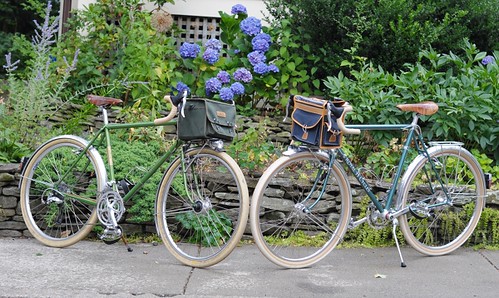
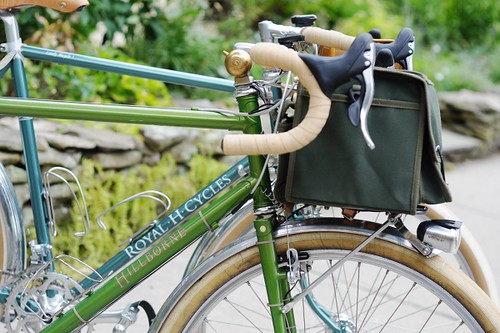
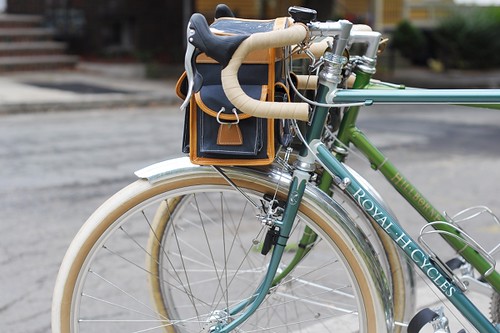
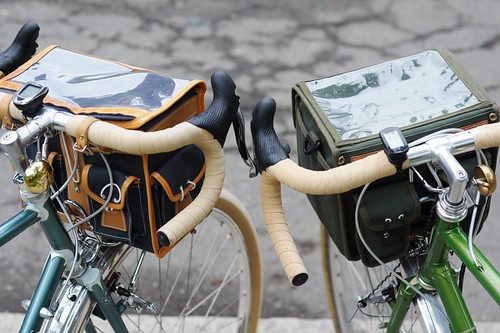
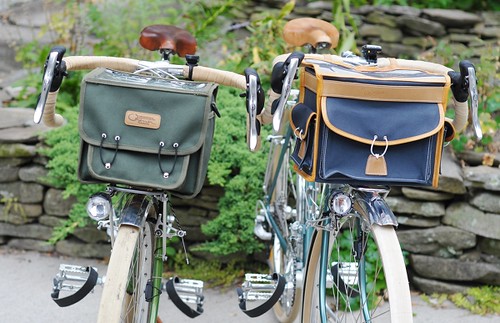
I agree on not quite getting what the hubbub is over low front trail. It feels a bit twitchier to me, and I think that it probably helps at lower speeds. I've been doing front loads on my Riv for quite a while now, and haven't felt uncomfortable. I certainly haven't done a ride longer than 50 miles, however. Perhaps that's when it makes a difference?
ReplyDeletehttps://picasaweb.google.com/100568264680323726954/FrontLoader#
I find high-trail bikes very much prone to shimmy or wobble in the front end with even just the weight of a full water bottle mounted right in front of the stem. Forget riding such a bike no-hands with any weight up front! Meanwhile, the low trail bikes I have ridden do not shimmy or wobble, no matter what, up front, and can be ridden no-hands easily and without care, with or without weight up front. I fully expected a low-trail bike to feel weird with no weight on the front end, but so far have not experienced anything weird about such bikes' handling: it's all positive.
ReplyDeleteInteresting.
ReplyDeleteWouldn't it be fun if there were more factory made bicycles with low trail numbers so more folks could get a feel for the differences and make a choice based on test rides vs availability?
Even within my own bicycle quiver I have two low trail bikes. One is very stable at all speeds and feels like you have turn the handlebars to make it want to turn versus leaning to steer on my higher trail bikes. The other low trail bike is twitchy up front at low speeds, but fine once it gets moving. *shrug*
Keep up the good work!
Uncanny. I'm about to buy a raw-lacquer Brompton, and I'm debating between a 650B Rivendell and something with less trail, so I'm finding your topics of choice quite relevant. I currently have a SimpleOne, with a handlebar bag. Oddly enough, this is the first bike I've ridden that I've been able to ride in a straight line hands-free (just trying to figure out how to do that, really), and I can do it even with some weight in the front bag -- enough to make the front wheel swing around abruptly when the bike is at rest. That's really been my only difficulty with it so far. Can you comment on any noticeable parked-wheel-flop differences between your Hillborne and the Randonneur?
ReplyDeleteMy "normal" trail bike (a pretty much standard Waterford road bike, although labeled Rivendell) certainly shimmies and wobbles above a certain weight up front. It's more than a pound or two, but once I get to filling up my handlebar bag I can no longer ride no-handed and fast decants are a bit more harrowing. It works though, and 90% of the time I don't carry that much weight up front anyway, so I don't worry about it. Same as anything on bikes, I think it's a combination of factors, the Riv might not have low-trail geometry, but it's certainly designed with a front load in mind.
ReplyDeleteStonehog - I actually felt that the low trail was more helpful at fast speeds, especially in how the bike turned. My rides on both bikes were typically 40-50 miles in duration, which granted is not endurance ride territory. But then I think that the majority of people who buy touring bikes (and would buy randonneuring bikes if they were more readily available) do not exceed these distances either.
ReplyDeleteXO-1 Sometimes I carry 15lb+ in the handlebar bag of my Rivendell and there is no shimmy. I would feel it right away; I am very sensitive to it. However, the weight is supported by a rack and does not rest on the handlebars. I do not like to carry stuff on the handlebars.
Jammy - Would you reveal which bikes they are?
ReplyDeleteThe Randonneur did have some very specific handling characteristics. But they were subtle and I would just have attributed them to the normal degree of difference between bikes had I not known it was low trail.
Merlin - (Oooh you have a Simple One!) Both bikes had "parked wheelflop" with the handlebar bags full.
I cannot comfortably ride no hands, so did not experiment with that - didn't want to crash a bike that did not belong to me! But I can cycle while resting my hands on the handlebars lightly on both bikes with weight in the front.
Well, no one has mentioned weight distribution yet, and its potential effect on steering and handling properties. If the Riv has a slacker seat tube angle, then the rider's weight can be expected to be shifted closer to the rear wheel and away from the front. This shift in weight distribution is even more pronounced when the handlebars are raised relative to the saddle height, as is the case with Velouria's Riv and many loaded touring bikes. This would make a high-trail bike's front end feel lighter. On a bike with a steep seat tube angle, the rider's weight is shifter forward. More weight on the front will make the steering feel more sluggish, and this is where low trail can compensate for this.
ReplyDeleteSo it's not fair to compare these two bikes as simply low trail and high trail 650B bikes (and bikes with flexy versus stout tubing). The main triangle angles play a part as well.
Right, though I did mention the difference in angle steepness. It is also worth noting that this factor can be somewhat manipulated by the back and forth adjustment of the saddle position. On the Rivendell I now have the saddle shoved quite a bit forward, whereas on the Randonneur it was in the middle position. In practice, there was probably 1 degree of diff in their seat tube angles. Also, my handlebars are now 2cm or so below the saddle on the Riv, not higher.
ReplyDeleteVelouria -- I should mention that I strongly prefer two-legged kickstands, so there's a major problem if the rear rack is loaded with, say, 30 pounds of vegetables. I'm thinking about making a centering spring to keep the front wheel at bay. Mostly, the front end is heavier, though, on account of the front bag and the generator hub.
ReplyDeleteSomervillain -- Weight distribution would also be affected by the length of the chainstays the top tube, and the head tube angle, and the fork rake, and the reach to the handlebar, and possibly even the length of the crank arms. Do you feel the angle between the hips and feet is particularly dominant? (I'm not trying to nitpick; I really do not have the breadth of experience to answer this question myself.)
Do you feel the angle between the hips and feet is particularly dominant? (I'm not trying to nitpick; I really do not have the breadth of experience to answer this question myself.)
ReplyDeleteWhether that angle is dominant itself for all riders on all bikes, I have no idea. It could be that chainstay length or TT length are more dominant in some cases.
But, this varies a lot from rider to rider and where the rider's weight is focused (upper versus lower body). And, the higher the stem relative to the saddle, the more the seat angle will be dominant.
Here's a better question (I think) about weight distribution --
ReplyDeleteWhat matters more: the percentage of the total load borne by the front wheel, or the amount of weight on the front wheel?
Then there's the three (at least) types of weight on the front end -- rider's weight (plus the rest of the bike) supported by the frame, rider's weight supported by the handlebars, and weight that rotates with the front wheel (e.g. front rack(s) and bag(s)).
It would be interesting to compare a given bike's handling characteristics with a front load attached to the fork and the same load attached to the frame...
BTW I do agree with somervillain's earlier comment that overall it's just not a fair comparison - and in a way this was part of my point in the post. I would venture to say that to the majority of casual readers the bicycles seem more or less identical except for the colour, but they are not.
ReplyDeleteI've ridden both "low trail" and "high trail," and honestly I cannot tell the difference either. There are far too many factors involved in how a bicycle feels; all this constant talk about trail is just silly and nearly hype.
ReplyDeleteI don't think it's hype, if only because geometry-wise such a significant numerical difference in trail is bound to translate into a difference in handling. The problem is that there are so many other factors thrown into the mix whenever anyone compares low to high trail bikes. In order to test for trail alone, one would need to try the same bike (or identical bikes) with 2 different forks, and not know which is which.
ReplyDeleteI can has high tail and then low tail. It depends on my mood. Not sure why humans find this tail thing so difficult.
ReplyDeleteI think the present emphasis on low-trail bikes is rather hyperbolic. I've ridden bikes that were mid to high trail for years. These bikes have been ridden with loads on the front and rear. I never experienced any problems with shimmy at high or low speeds.
ReplyDeleteTotal hype, driven by one guy - Jan Heine.
ReplyDeleteGR Jim - In the Boston area lots of old-timer enthusiasts have been into bikes since before Jan Heine's publication was in existence. Two of them have independently praised the qualities of classic randonneur handling to me, uninfluenced by JH. That's not to say it's necessarily not hype - only that it's not driven by one guy.
ReplyDeleteI'm not against re-enactment bikes as it's just another way to skin a cat. Trouble is when one guy makes it his personal mission to say this is better than that. Lately, wisely, he's backed off on the vitriol.
ReplyDeleteThe vast majority of riders who finished PBP are riding standard race/road bikes set up to work for them, period. Americans with modern versions of old bikes are seen as curiosities.
V- As you've stated, a blind test of two identical bikes with different trail forks would be one place to start. I think, however, that there are too many variables to attribute major differences in handling to one single geometry factor.
ReplyDeleteI know of two specific instances where low-trail bikes have been built by custom builders that suffered from terrible shimmy. One, made as a prototype by Boulder Bicycles (Rene Herse) was referred to as the "Shimmy Monster" (http://www.flickr.com/photos/7556426@N06/3001542010/in/photostream.)
The other, made locally by another experienced custom builder, had such bad shimmy that the owner could not use the bike as they had intended (heavy duty touring with loaded front panniers).
There's a lot of things going on with bike handling and geometry. To reduce it to one single factor is simply not correct.
There are some posters on the forums who claim they can't ride their Rivendells with a front load because Grant Peterson designs his bikes with high trail. One poster claimed his Rivendell "bucked" with the load of a handlebar bag.
PLEASE... I've ridden my high-trail Rivendell Road Standard many miles with a handlebar bag, and - I'm sorry - I didn't get "bucked" out of the saddle!
I just took delivery of my rebuilt ANT Club Racer. I had dropped it off with Mike after getting hit by a car in July. and, prior to that, we had been talking about redoing the fork to experiment with low trail geometry. At the time of the accident, the project was shelved because he was too busy, but after talking about it further, we decided to go ahead with it. The old, non weight-bearing light rack with the two E6s that appeared in a photo in VBQ after the 2007 PBP was replaced with a fancy new bag rack with an Edelux and the bag that's on there now was sewed up by another friend. The rest of the geometry is the same, it's just the fork that's different (though various parts (ie. cranks, handlebar, etc.) were also replaced post crash, all parts were equivalent to their pre-crash versions)
ReplyDeleteI haven't ridden it with a completely unladen front load, but even lightly laden, the handling is a little different. It doesn't shimmy, just slips a bit to one side or another, especially on hard efforts like climbing or hard acceleration on a flat. The slippage effect goes away if I put more weight on the front (like this morning, riding to work with a 6 lb. laptop strapped to the front rack) and it's also -much- easier to ride hands-free if the front is loaded down, unlike its previous iteration where having any kind of bag in addition to the rack lights would've excacerbated the wheel flop.
I have yet to take the bike out on a long ride out of the city (or on a very steep, fast descent) but I'll update if I get a chance (though that likely won't be until October)
cris--glad to hear your bike has been rebuilt.
ReplyDeleteDitto Cris!
ReplyDeleteLooking forward to hearing more about it.
I'll be getting my very own ANT any week now as well : )
I'll be getting my very own ANT any week now as well : )
ReplyDelete???!!!???!!!???!!! Oh, Lordy. Details, now that the cat it out of the bag!
It wasn't in the bag, pretty sure I've mentioned it before. I've been doing photography for Mike in exchange for a truss frame. Not sure when exactly it will be done, and we probably won't put the complete bike together for a while, so haven't announced it formally. But later in the Fall I'm hoping to have more details.
ReplyDeleteOh, yeah, I remember that now.
ReplyDeleteIt might actually be slightly low-trailish as a means to avoid toe overlap, though I forget now the geometry we decided on. Will be an interesting surprise.
ReplyDeleteThere's no one factor that determines handling. Front end geometry, weight distribution, tire width and pressure, and wheelbase all come into play.
ReplyDeleteHere's the most interesting experiment in front-end geometry I've read online. http://forums.mtbr.com/29er-bikes/fork-rake-trail-head-angle-experiments-26536.html
Interesting, thanks for the link.
ReplyDeleteaww ... thanks, you guys. Looking forward to seeing your ANT review.
ReplyDeleteThat's it? I was really looking forward to this review. I have read Bicycle Quarterly for several years, and have been intrigued by Jan's conclusions (and advocacy) for low trail, thin tubing, non-oversize tubing, Randonneur bikes. I have to say I'm disappointed that you were not able to come to much definitive conclusion about handling differences, or even your overall preference for one bike or other. However I don't know whether I should be disappointed with you (Silly Beginner, can't detect big differences that must be there), or with Jan himself (Silly Expert, can't stop himself from obsessing about small differences that are nearly undetectable to most riders)!!!
ReplyDeleteAnon - This is not an actual review, just a comparison to my Rivendell. I get emails asking how the two bikes compare and I don't plan to give that topic a great deal of attention in he actual review because in reality the bikes are too different to compare. Hope that makes sense.
ReplyDeleteAlso, to clarify - The handling of the two bikes is quite different, and I will describe the Randonneur's handling in detail in a separate post or article. It's specifically in carrying a handlebar bag that I don't detect a significant difference - meaning an additional different aside form the already existing differences. Hope that makes sense, too.
ReplyDeleteHere's a simple method for weighing a bike. Take your bathroom scales to where you keep your bike. Weigh yourself. Let's call your weight 'x'.
ReplyDeleteThen (while still on the scales) lift the bike off the ground and note what the weight is now. Call this gross weight 'y'.
The weight of your bike = y minus x.
The Randonneur weighed 26lb as shown in the pictures (empty handlebar bag) and the Rivendell weighs 31lb.
ReplyDeleteI will have the Randonneur review here very soon, and the Bicycle Quarterly article will appear in the Spring 2012 issue. I did not want to post a review before the BQ article was finilised, so that the content of the two would not overlap.